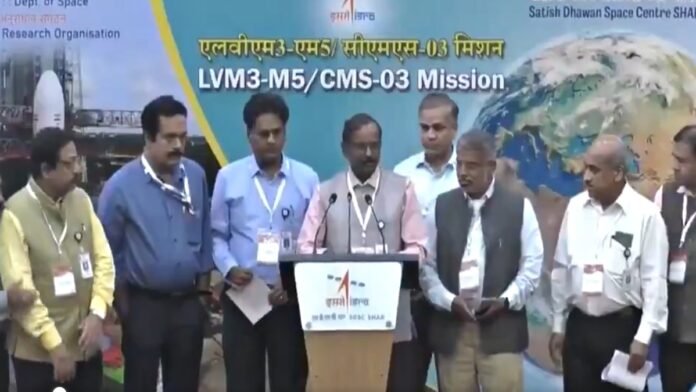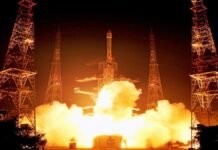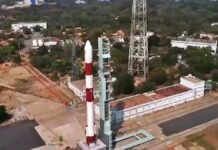
Key Points:
- ISRO Chairman V. Narayanan announced plans to complete 7 space missions by March 31, 2026, following successful launch of India’s heaviest communication satellite CMS-03 (GSAT-7R) on November 1, 2025
- First unmanned Gaganyaan mission (G1 Mission) scheduled before March 2026; all hardware has arrived at Sriharikota and integration is underway
- Three unmanned Gaganyaan test flights planned before India’s maiden crewed spaceflight mission
- Prime Minister Modi’s vision targets 50 rocket launches over next 5 years (2025-2030), positioning India as a major global space power
- Upcoming missions include: 1 more LVM3 launch (commercial client), 3 PSLV missions (including NSIL customer satellite and technology demonstration PSLV-N1), and 1 GSLV-F17 mission
- CMS-03 weighing 4,410 kg is India’s heaviest satellite launched to Geosynchronous Transfer Orbit, replacing Navy’s GSAT-7 for secure multi-band communications
- LVM3-M5 rocket (43.5 meters tall, 642 tonnes) successfully placed CMS-03 into orbit approximately 16 minutes after liftoff from Satish Dhawan Space Centre
- ISRO’s commercial arm NewSpace India Limited (NSIL) will handle multiple client satellite launches as part of India’s expanding space commerce capabilities
Sriharikota: The Indian Space Research Organisation has unveiled an ambitious roadmap that includes seven major space missions before the end of the current financial year, marking a significant acceleration in India’s space exploration capabilities. ISRO Chairman V. Narayanan made this announcement on Sunday, November 1, 2025, immediately following the successful launch of the communication satellite CMS-03 aboard the powerful LVM3-M5 rocket from the Satish Dhawan Space Centre in Sriharikota.
Historic CMS-03 Launch Sets Stage
The LVM3-M5 mission, which took place from the Second Launch Pad at Sriharikota, saw the 43.5-meter-tall rocket weighing a massive 642 tonnes lift off amid bright orange plumes and thunderous applause from mission control. Approximately 16 minutes after liftoff, the rocket successfully injected the 4,410 kg CMS-03 satellite into its intended geosynchronous transfer orbit with an apogee of approximately 29,970 kilometers. The CMS-03 satellite, also known as GSAT-7R, represents India’s heaviest payload ever launched to GTO and will provide secure, multi-band communications over the Indian Ocean region for an estimated operational life of 15 years.
50 Launches in 5 Years
Speaking to reporters after the successful launch, Narayanan emphasized that the seven planned missions align with Prime Minister Narendra Modi’s broader vision for ISRO to achieve 50 rocket launches over the next five-year period from 2025 to 2030. This ambitious target would represent a dramatic increase in India’s launch cadence and position the country as one of the world’s most active spacefaring nations. Narayanan acknowledged the challenge ahead, stating, “I know it is not an easy job. It is a tough job. But I know that we will accomplish these activities in the future”.
Gaganyaan G1: India’s First Unmanned Space Mission
The most anticipated mission in ISRO’s near-term schedule is the first unmanned test flight under the Gaganyaan human spaceflight program, designated as the G1 Mission. Narayanan provided encouraging updates on the program’s progress, confirming that it has reached advanced stages with all necessary hardware now delivered to the Satish Dhawan Space Centre at Sriharikota. The integration of critical systems is currently underway at the facility.
Three Unmanned Flights Before Crewed Mission
ISRO has meticulously planned three unmanned missions before attempting India’s maiden crewed spaceflight. These unmanned test flights are crucial for validating critical systems, including the crew module safety mechanisms, environmental control systems, life support infrastructure, and re-entry procedures. Narayanan stated, “Our Gaganyaan programme is progressing well. It is in advanced stages. All hardware has arrived at Sriharikota, and integration of the hardware is happening. We have planned three uncrewed missions. The first uncrewed mission, ‘G1 Mission’, is going to be achieved before the end of the current financial year”.
Technology Validation Critical for Human Safety
The unmanned Gaganyaan flights will serve as comprehensive end-to-end system validation exercises, testing everything from launch vehicle performance to crew module separation, orbital maneuvers, atmospheric re-entry, and parachute-assisted landing. These missions will also validate the crew escape system, which is designed to safely extract astronauts in case of launch emergencies. Only after successful completion of all three unmanned missions will ISRO proceed with the historic crewed mission that will make India the fourth nation, after Russia, the United States, and China to independently send humans to space.
Second LVM3 Launch: Commercial Communications Satellite
Following the successful LVM3-M5 mission, ISRO plans to launch another LVM3 rocket carrying a commercial communication satellite for an international client. This mission underscores India’s growing capabilities in the commercial space launch market, where ISRO competes with established players like SpaceX, Arianespace, and Russia’s Roscosmos. The LVM3, often referred to as “Bahubali” in reference to the blockbuster Indian film, has proven its reliability through successful missions including Chandrayaan-3’s historic lunar landing and the Gaganyaan test vehicle flight.
Three PSLV Missions on the Schedule
The workhorse of India’s space program, the Polar Satellite Launch Vehicle (PSLV), will see three missions before March 2026. One of these PSLV missions is dedicated to launching a customer satellite for NewSpace India Limited (NSIL), ISRO’s commercial arm responsible for enabling space sector partnerships and executing satellite launches for global clients. NSIL plays a crucial role in monetizing ISRO’s launch capabilities and building international partnerships in the space sector.
PSLV-N1: Technology Demonstration Mission
Among the planned PSLV missions, ISRO has scheduled a particularly significant technology development mission designated PSLV-N1, targeted for launch before the end of the current fiscal year. Narayanan mentioned this mission specifically, stating, “So many developments are taking place. We have also planned for another technology development mission PSLV-N1 targeted to be launched before the end of the current financial year”. While specific details about the PSLV-N1 payload and objectives have not been publicly disclosed, technology demonstration missions typically test new systems, sensors, or operational procedures that will be incorporated into future missions.
GSLV-F17 Mission Planned
The Geosynchronous Satellite Launch Vehicle (GSLV), India’s medium-lift launcher capable of placing satellites into geosynchronous orbits, will also see action before March 2026. The GSLV-F17 mission is confirmed on ISRO’s schedule, though the specific payload has not been officially announced. According to earlier schedule discussions within the space community, GSLV-F17 is expected to carry NVS-03, a navigation satellite for India’s NavIC (Navigation with Indian Constellation) regional satellite navigation system.
Breakdown of Seven Missions
To summarize, ISRO’s seven missions planned by March 2026 include: (1) LVM3 launch carrying a commercial communication satellite, (2) PSLV mission for NSIL customer satellite, (3) PSLV-N1 technology demonstration mission, (4) Third PSLV mission (likely PSLV-C63 with Oceansat-3A), (5) Gaganyaan G1 unmanned mission, (6) GSLV-F17 launch, and (7) potentially an additional mission yet to be specified. This aggressive schedule represents approximately one launch every month for the remainder of the fiscal year.
Industry Leaders Applaud ISRO’s Progress
India’s space industry leaders have enthusiastically welcomed ISRO’s ambitious plans and praised the successful CMS-03 mission. Lt Gen (Retd) Anil K. Bhatt, Director General of the Indian Space Association, described the mission as a “monumental achievement” that significantly strengthens India’s maritime and national security communications network. Industry experts note that the 4,410 kg CMS-03 satellite demonstrates India’s growing self-reliance in strategic communication technology, reducing dependence on foreign satellite capacity for critical defense and government communications.
Enhanced Heavy-Lift Capabilities
The successful launch of CMS-03, India’s heaviest satellite to Geosynchronous Transfer Orbit, represents a major leap in the country’s heavy-lift launch capabilities. The LVM3 rocket has consistently demonstrated its ability to carry increasingly heavier payloads, with each successful mission building confidence in the vehicle’s performance and reliability. This capability is crucial for India’s ambitions in both commercial and strategic space sectors, enabling the launch of larger, more sophisticated satellites without relying on foreign launch providers.
Expanding Commercial Space Footprint
ISRO’s focus on commercial satellite launches through multiple missions reflects India’s strategic push to capture a larger share of the global space launch market. NewSpace India Limited, established in 2019 as ISRO’s commercial arm, has been instrumental in opening up India’s space capabilities to international customers. By dedicating several of the seven planned missions to commercial clients, ISRO is demonstrating its commitment to building a sustainable business model that can generate revenue while advancing scientific objectives.
Strategic Importance of CMS-03
The CMS-03 satellite serves as a crucial upgrade to India’s military communication infrastructure, replacing the aging GSAT-7 satellite that has been serving the Indian Navy. With its multi-band communication capabilities operating over the Indian Ocean region, CMS-03 will provide secure, reliable communications for naval vessels, maritime patrol aircraft, and coastal installations. The satellite’s 15-year operational life ensures long-term communication security for India’s maritime domain awareness and naval operations.
Team ISRO Gears Up for Intensive Period
Narayanan expressed confidence in his team’s ability to meet the challenging schedule ahead, acknowledging that executing seven complex missions in approximately five months would require exceptional coordination and effort. He stated, “Team ISRO is geared up to meet the vision of the Prime Minister to launch 50 missions in the next 5 years”. This statement reflects the organization’s commitment to transforming India’s space program from a primarily research-focused agency into a high-cadence, operationally efficient space power capable of supporting both national needs and commercial aspirations.
Historical Context and Future Trajectory
ISRO’s planned acceleration in launch frequency represents a dramatic shift from its historical launch cadence. For much of its history, ISRO conducted between 3-5 launches per year, focusing on quality and reliability over quantity. The new target of 10 launches per year (50 over 5 years) would place India among the world’s most active space agencies, comparable to China’s current launch rate and approaching the frequency achieved by the United States. This transformation is being enabled by investments in infrastructure, streamlined processes, increased private sector participation, and the expansion of launch vehicle production capabilities.
Challenges and Critical Path
While ISRO’s ambitions are laudable, space industry analysts note that maintaining such an aggressive schedule poses significant challenges. Each mission requires meticulous preparation, testing, and integration, with any technical issues potentially causing cascading delays across the schedule. The Gaganyaan G1 mission, in particular, represents a new class of mission for ISRO with unique safety and reliability requirements that cannot be compromised. Weather conditions, hardware availability, range safety clearances, and coordination with international tracking stations all contribute to scheduling complexity.
India’s Space Program at Inflection Point
ISRO’s announcement of seven missions by March 2026 and 50 missions over five years marks a pivotal moment in India’s space journey. As the country prepares to send its first astronauts to space, expand its commercial launch services, and maintain its position as a cost-effective yet reliable launch provider, the coming months will test ISRO’s organizational capabilities like never before. Success in meeting these ambitious targets would not only fulfill national prestige objectives but also position India as an indispensable player in the global space economy, offering affordable access to space for nations and companies seeking alternatives to traditional launch providers.





















































